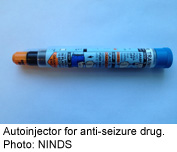
WEDNESDAY, Feb. 15 (HealthDay News) — Using an autoinjector device to deliver anti-seizure drugs into muscle is a fast, safe and effective way to treat status epilepticus, a prolonged type of seizure that lasts longer than five minutes, researchers report.
“This is a very important study for persons with epilepsy,” said one outside expert, Dr. Jacqueline French, first vice president of the American Epilepsy Society. “Prolonged seizures and status epilepticus can lead to brain damage, prolonged hospitalization, and other serious harm. The earlier treatment is initiated, the greater the likelihood that the seizure activity can be aborted quickly, and harm can be avoided,” she said.
French, who is also professor of neurology at the Comprehensive Epilepsy Center at New York University Langone Medical Center, New York City, believes the study “will set a new standard for treatment by emergency teams, that will lead to substantial benefit for persons with epilepsy.”
The study, funded by the U.S. National Institute of Neurological Disorders and Stroke (NINDS), appears in the Feb. 16 issue of the New England Journal of Medicine.
Status epilepticus is a serious, potentially life-threatening medical emergency that causes 55,000 deaths each year in the United States. First-line treatment typically involves intravenous (IV) delivery of anti-seizure drugs. However, starting an IV in a patient having a seizure can be challenging for paramedics and takes up precious time.
This study, carried out by paramedics, examined whether using an autoinjector to deliver an anti-seizure drug directly into a patient’s thigh muscle is as safe and effective as using an IV. The researchers compared how well each method stopped patients’ seizures by the time the ambulance arrived at the emergency department.
Two different seizure-fighting medicines — midazolam and lorazepam — were used in the study. Both are benzodiazepines and are known to be effective in controlling seizures. Midazolam was used in the autoinjectors because it is rapidly absorbed from muscle.
The researchers say that 73 percent of patients who received midazolam through an autoinjector were seizure-free when they arrived at the emergency department, compared with 63 percent of those who received IV treatment with lorazepam.
Patients in the autoinjector/midazolam group were also less likely to require hospitalization than those in the IV/lorazepam group. Both groups had similarly low rates of recurrent seizures.
“Patients with status epilepticus can suffer severe consequences if seizures are not stopped quickly. This study establishes that rapid intramuscular injection of an anticonvulsant drug is safe and effective,” Dr. Walter Koroshetz, NINDS deputy director, said in an institute news release.
Another expert agreed.
“This study represents a major step toward keeping epilepsy patients safer from the serious neurologic and medical risks of prolonged status epilepticus,” said Dr. Cynthia Harden, chief of the Division of Epilepsy and Electroencephalography at the Cushing Neuroscience Institute, part of the North Shore-LIJ Health System in Manhasset, N.Y.
Could the autoinjector be safely used by non-medical personnel, such as family or friends? Harden said only more research can tell. “The device has great value in the clinical setting, when used by paramedics,” she said, “and the safety of its use by non-medical persons such as family members remains to be clarified.”
The study authors agreed. Currently, they said, the use of midazolam requires on-site medical supervision, and further research is needed before autoinjectors with the drug might be available for use by epilepsy patients and their family members.
More information
The Epilepsy Foundation has more about status epilepticus.

